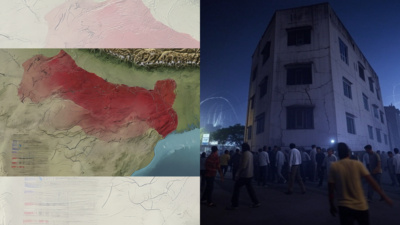NEW DELHI: Residents of Delhi-NCR and several parts of northern India were jolted awake early Monday morning as strong tremors shook high-rise buildings, prompting many to rush outdoors. The earthquake struck at 5:36 AM IST with its epicentre at Dhaula Kuan, according to the National Centre for Seismology (NCS).
Though a 4.0-magnitude quake is considered moderate, its impact felt stronger than usual due to its shallow depth of 5 km and close proximity to densely populated areas. “It is called a shallow-depth earthquake, hence people felt the effect. People panicking was natural,” NCS Director OP Mishra said. He clarified that the quake was not caused by plate tectonic movements but was instead due to “in situ material heterogeneity,” meaning it resulted from local geological conditions rather than large-scale tectonic shifts. Mishra also noted that aftershocks of around 1.0 to 1.2 magnitude could follow.
Experts say shallow earthquakes—those occurring at depths of less than 10 km—are felt more strongly as seismic waves have less distance to dissipate before reaching the surface. Additionally, the earthquake’s epicentre being within the city meant its effects were magnified, particularly in high-rise buildings designed to sway during seismic events.
Why is Delhi prone to earthquakes?
Delhi is geographically vulnerable to seismic activity due to its location near the collision zone of the Indian and Eurasian Plates. The Indian Plate is moving northward at a rate of 5 cm per year, pushing against the Eurasian Plate, a process that continues to build stress along major fault lines. This tectonic activity is responsible for the formation of the Himalayas and is also the primary reason why northern India experiences frequent earthquakes.
Adding to Delhi’s seismic risk is its position in Seismic Zone IV, indicating a high probability of moderate-to-strong earthquakes. Unlike Himalayan quakes triggered by plate tectonics, Monday’s earthquake was an intra-plate event, caused by localised stress within the crust. According to OP Mishra, the tremor was due to “in situ material heterogeneity”, meaning variations in underground rock formations rather than large-scale plate movements.
The fault lines affecting Delhi
Delhi is affected by multiple active fault systems, including:
Himalayan Seismic Belt : The Main Central Thrust (MCT) and Main Boundary Thrust (MBT) in the Himalayan region generate powerful earthquakes, which can have significant effects in Delhi. Major earthquakes such as the 1905 Kangra earthquake (7.8 magnitude) and the 2015 Nepal earthquake (7.8 magnitude) were felt across northern India.- Delhi-Haridwar Ridge & Aravalli Fault System: The Delhi-Haridwar Ridge is an extension of the Indian Plate running beneath the capital, making it prone to intra-plate tremors. The Aravalli-Delhi Fault System, a deep-seated geological structure, has also been responsible for past seismic events.
- Indo-Gangetic Plain & Soil Amplification: Much of Delhi-NCR sits on soft alluvial soil, which amplifies seismic waves. This phenomenon explains why even moderate tremors feel stronger and cause greater structural damage than in regions with stable rocky terrain.
What is a seismic zone?
A seismic zone is a geographical region classified based on its earthquake risk and historical seismic activity. India is divided into four seismic zones—Zone II, III, IV, and V—where Zone II has the least risk and Zone V has the highest. Delhi falls under Seismic Zone IV, which is considered a high-risk category. This classification is determined by the Bureau of Indian Standards (BIS) based on past earthquakes and geological studies.
Historical earthquake activity in the region
Delhi and its surrounding areas have experienced notable earthquakes in the past. Some of the strongest include:
- 1720 Delhi Earthquake (~7.5 magnitude)
- 1803 Mathura Earthquake (~7.5 magnitude, felt strongly in Delhi)
- 2015 Nepal Earthquake (7.8 magnitude, caused widespread panic)
- 2023 Nepal Earthquake (6.4 magnitude, tremors reported in Delhi)
Is Delhi at risk of a major earthquake?
Scientists warn that a powerful earthquake (>8.0 magnitude) in the Himalayas is overdue, which could have devastating consequences for Delhi and northern India. The ongoing accumulation of tectonic stress along the Himalayan fault system increases the likelihood of a major seismic event.
While local tremors like Monday’s may not be directly linked to this larger seismic risk, they serve as a reminder of Delhi’s vulnerability. Experts suggest retrofitting older buildings, enforcing stricter seismic codes, and improving earthquake preparedness to mitigate potential damage in the future.
Delhi’s frequent earthquakes are a result of its proximity to the active Himalayan seismic belt, the movement of the Indian Plate, and local fault systems. The soft alluvial soil further amplifies seismic waves, making tremors feel stronger than their actual magnitude. Given the high strain accumulation in the region, experts caution that preparedness is key to minimising damage from future seismic events.


